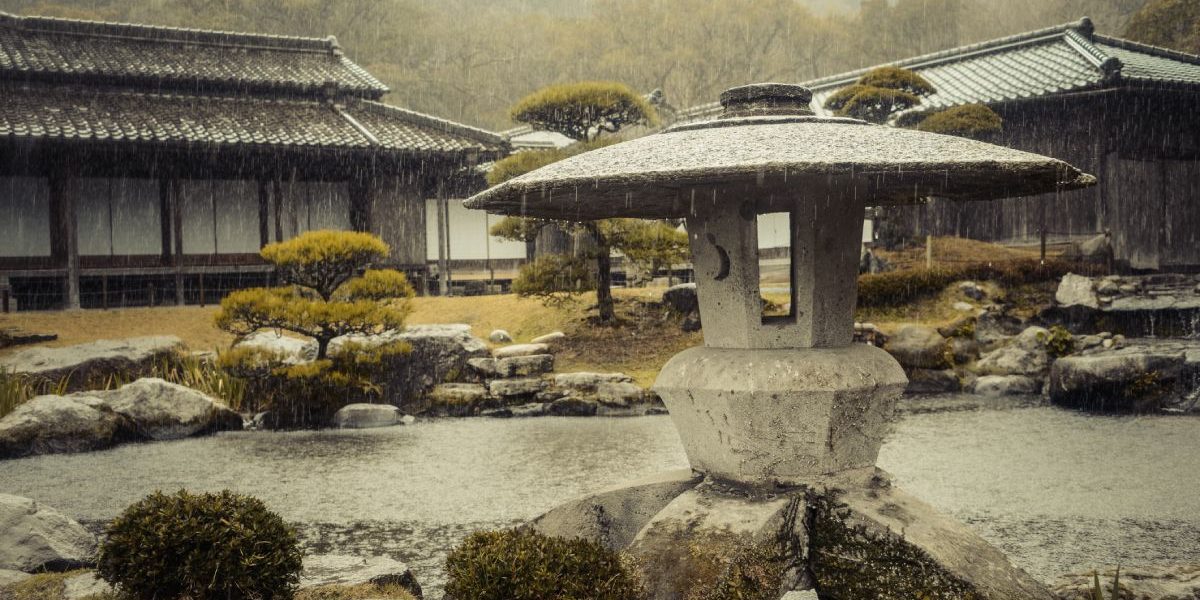In a world that often seems to be in perpetual motion, where the noise of modern life can be overwhelming, there exists a serene oasis that invites contemplation, tranquillity, and harmony. This oasis is none other than the Zen garden, a timeless creation that has its roots deeply embedded in Japanese culture and philosophy.
A Zen garden, also known as a Japanese rock garden or Karesansui is far more than just an arrangement of stones and sand. It is a living work of art that offers a profound glimpse into the heart of Zen Buddhism and the essence of mindfulness. The true essence of a Zen garden transcends its physical attributes; it is a profound journey toward self-discovery and inner peace.
The goal of a Zen garden is to serve as a sacred space where visitors can embark on a spiritual journey of self-discovery and inner peace, deeply intertwined with Japanese culture, Buddhist philosophy, and a celebration of nature.
What is a Zen garden?
At first glance, a Zen garden may appear to be a minimalist landscape, characterised by carefully raked gravel or sand and an assortment of carefully placed rocks and stones. However, the true essence of a Zen garden lies beyond its physical attributes. It is a space meticulously designed to evoke a sense of tranquillity, simplicity, and inner peace. Every element within a Zen garden has a purpose, and its arrangement is carefully considered to encourage mindfulness and meditation.

The Elements of a Zen Garden
- Sand or Gravel: The most distinctive feature of a Zen garden is the carefully raked sand or gravel, which often serves as the canvas upon which the other elements are arranged. The act of raking the sand is a form of moving meditation, helping individuals find a sense of focus and calm.
- Rocks and Stones: These are the core elements of a Zen garden and are carefully placed to create a harmonious composition. Each rock or stone is chosen for its shape, size, and texture, and its arrangement is symbolic, representing islands, mountains, or other natural elements.
- Moss and Plants: While Zen gardens are primarily minimalist, they may also include small patches of moss or a few carefully chosen plants. These elements add a touch of life and colour while maintaining a sense of simplicity.
- Bridges and Paths: Some Zen gardens incorporate bridges or stepping stones to guide visitors through the space. These pathways encourage mindful walking, allowing individuals to focus on each step and their surroundings.
The Philosophy Behind Zen Gardens
Zen Buddhism, which heavily influences the design and purpose of Zen gardens, emphasises living in the present moment and seeking enlightenment through meditation and mindfulness. A Zen garden reflects these principles by providing a space where individuals can disconnect from the chaos of daily life and find a sense of inner calm.
The act of raking the sand or gravel, arranging stones, and tending to the garden is a form of meditation in itself. It encourages contemplation, self-reflection, and the cultivation of patience. The simplicity of the garden design encourages individuals to let go of distractions and fully engage with the present moment.

What is the goal of a Zen garden?
The true essence of a Zen garden lies not in its physical appearance, but in the experience it provides and the inner transformation it fosters. Therefore, the goal of a Zen garden transcends the mere aesthetics; it is a profound journey toward self-discovery and inner peace.
- Cultivating Mindfulness: At the heart of a Zen garden lies the practice of mindfulness. The act of tending to the garden—raking the sand, placing stones, and caring for the plants—is a meditative process. They learn to be present in the moment, fully absorbed in the task at hand, and free from the distractions of a busy mind.
- Encouraging Contemplation: The Zen garden is a space for deep contemplation. As visitors walk through the garden or sit in quiet reflection, they are prompted to contemplate life’s profound questions and their own place in the universe. The simplicity and order of the garden provide a backdrop for profound inner exploration.
- Fostering Tranquility: The ultimate goal of a Zen garden is to create an atmosphere of tranquillity. The carefully designed layout, with its balanced and harmonious elements, is meant to evoke a sense of calm and serenity. Visitors are invited to release their stress and worries as they immerse themselves in the peaceful ambience.
- Promoting Balance: Zen philosophy places great importance on balance and harmony. A well-designed Zen garden embodies these principles by achieving a delicate equilibrium between its elements. Each stone, plant, and grain of sand has its place, and their arrangement reflects the idea that balance can be found even in the most minimalistic and seemingly chaotic aspects of life.
- Awakening Inner Wisdom: Zen gardens are often imbued with symbolism, and their elements can represent various aspects of life and nature. As individuals engage with these symbolic elements, they may uncover insights and wisdom that can be applied to their own lives. It is said that the act of observing and contemplating the garden can lead to moments of enlightenment, or satori, in which one gains a deeper understanding of oneself and the world.
- Promoting Connection to Nature: While Zen gardens are often associated with dry landscapes, they are also a way of connecting with nature in a controlled and intentional manner. The inclusion of natural elements like rocks, sand, and plants allows individuals to establish a profound connection with the natural world, even in urban environments.
What Culture is Zen Garden?
The Zen garden, with its deep spiritual and philosophical roots, is an iconic creation deeply intertwined with Japanese culture. While it is often referred to as a Japanese rock garden, it’s essential to understand that its origins trace back to the distinctive blend of Buddhism, Taoism, and Shintoism that characterises Japan’s cultural and religious landscape.
Zen Buddhism and Its Influence
The most significant influence on the development of Zen gardens is Zen Buddhism, or simply Zen. This school of Buddhism, which emphasises direct experience and meditation as the path to enlightenment, arrived in Japan from China in the 12th century. Zen monasteries often incorporated gardens as a place for meditation and contemplation. Over time, these gardens evolved into the iconic Zen gardens we recognise today.
Japanese Aesthetics
Zen gardens are an embodiment of Japanese aesthetics, which place a strong emphasis on simplicity, balance, and harmony. These principles, known as “Wabi-Sabi,” celebrate the beauty of imperfection and transience. In a Zen garden, every element is carefully chosen and positioned to create a sense of balance and harmony while embracing the impermanence of nature.

Shintoism and Nature Worship
Shintoism, Japan’s indigenous religion, also plays a role in the creation and maintenance of Zen gardens. Shintoism centres on the veneration of natural elements, spirits, and kami (divine beings). Zen gardens often incorporate natural elements like rocks, sand, and plants to connect with Shinto beliefs, fostering a sense of oneness with nature.
Taoist Influence
Taoism, a Chinese philosophical tradition, contributed to the Zen Garden’s aesthetics and philosophy. Taoist principles, such as the concept of “wu wei” (effortless action), are reflected in the garden’s design, which aims to create a space that appears simple and natural, yet is meticulously planned and cultivated.
Historical Evolution
The history of Zen gardens is not static; it reflects Japan’s evolving cultural and religious landscape. Over the centuries, Zen gardens have evolved in style and purpose, adapting to changing societal and artistic trends while maintaining their core principles of mindfulness and simplicity.
Cultural Significance
Zen gardens have not only served as places for meditation and reflection but have also played a crucial role in the aesthetic and spiritual development of Japanese culture. They have influenced various art forms, including painting, poetry, and architecture, and have left an indelible mark on the Japanese way of life.
In contemporary times, the influence of Zen gardens extends beyond Japan’s borders. Their serene beauty and profound philosophy have captivated people worldwide, leading to the creation of Zen-inspired gardens in diverse cultures. These gardens serve as a testament to the universal appeal of mindfulness, simplicity, and the timeless wisdom embodied in the Zen garden.
In summary, the Zen garden is a cultural gem rooted in the rich tapestry of Japanese culture, philosophy, and spirituality. Its enduring allure continues to inspire individuals around the world to seek inner peace, mindfulness, and a deeper connection with nature and themselves.
Conclusion
As we conclude our exploration of Zen gardens, we find that these serene landscapes represent more than just physical beauty. They are gateways to a world of mindfulness, simplicity, and profound spiritual insight.
Born from the fusion of Japanese culture, Zen Buddhism, and the celebration of nature, Zen gardens continue to stand as timeless sanctuaries where individuals can discover the transformative power of the present moment.
In an ever-changing world, the wisdom of the Zen garden remains a testament to the enduring human quest for inner peace and harmony.











